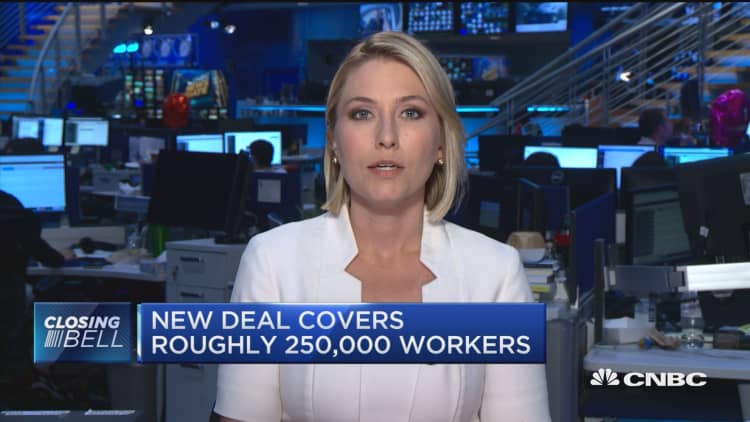While predictions across the board about employee pay are forecasting slower wage growth next year, there's a notable exception: union workers, especially those in service and manufacturing roles.
They have a long way to go. Compensation for union workers is up just 11% since the first quarter of 2020, compared with 14.6% for nonunion workers, according to Bureau of Labor Statistics data from the second quarter of 2023.
However, wages for union workers grew 4.6% alone in the second quarter of 2023, narrowing the gap with employees who do not belong to unions. The rise in pay growth for unionized employees this year stems, in part, from significant labor action, including a string of labor deals resulting in higher pay.
More from Personal Finance:
Most middle-income Americans still earn less than 3% on savings
The 'radically different' wage growth forecast in 2024
Job perks other than a 4-day workweek may be an easier to get
The latest data does not reflect recent deals between the United Auto Workers and Ford Motor Company, General Motors and Stellantis, where some employees could receive 25% wage increases. At Ford and Stellantis, employees could see their top wage boosted to more than $40 an hour, and starting wages could jump 68%, to $28 an hour, the UAW said.
While those pay jumps seem significant, collective bargaining agreements are often locked in for several years due to contracting periods and restrictions for how workers can negotiate. Many unionized workers, for example, haven't negotiated a new contract since the Covid-19 pandemic began.
"Unionized workers couldn't see the same scale of wage increases over the past few years that non-unionized workers did," said Aaron Terrazas, Glassdoor's chief economist. "To some degree, they're now catching up."

In other words, it is a particularly prudent time for unionized workers to organize as they enter new contracting periods, experts day.
Cumulative wage growth is still faster for nonunionized workers than for unionized workers, but the gap is narrowing, said Julia Pollak, chief economist at ZipRecruiter.
Through Oct. 9 this year, approximately 453,000 workers have participated across a total of 312 strikes, significantly higher than the 180 strikes involving 43,700 workers during the same period two years ago.
The data is compiled by Johnnie Kallas, a Ph.D. candidate at Cornell University's School of Industrial and Labor Relations, and the project director of the ILR Labor Action Tracker.
Union jobs can be less vulnerable, though underpaid
In general, union worker wages are less vulnerable to booms and busts in the labor market compared to nonunionized workers, Terrazas said.
"The end result is that the strikes seem like they're kind of picking up while wages are kind of winding down," Indeed economist Cory Stahle explained.
On the opposite end, LaCinda Glover, a senior principal consultant at Mercer, said she did not expect to see large upward swings in compensation in tech and health care, both of which are fighting layoff or financial pressures from increased spending during the pandemic.
"They have invested so much in compensation over the last few years that it's really not sustainable," she said.
Don't miss these CNBC PRO stories:
- Want to retire in 5 years? Here's how to invest for it, according to the pros
- Morgan Stanley says the average stock is breaking down, S&P 500 to fall to 3,900 by year-end
- This highly profitable industry is booming as the population ages
- This chip stock is getting a ton of love from Wall Street, and it's not Nvidia

